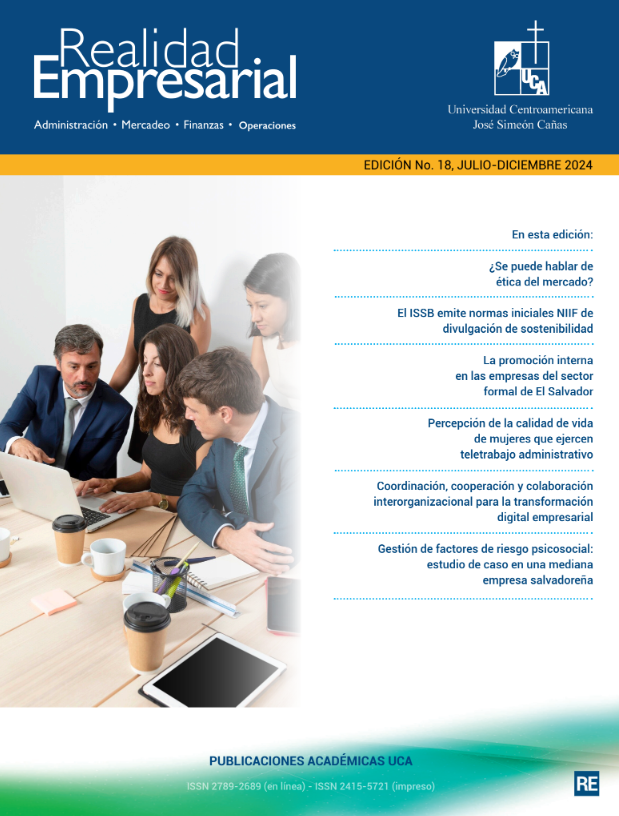Abstract
The ability of an entrepreneur to create is limited by the lack of resources. Among the dominant resources in emerging countries, the creation and adoption of new technologies stands out. It is understood that the power to compete and lead in the markets resides in the rarity and distinction in the selection of resources. Many companies choose to increase the complexity of their products and promote the sophistication of services, however; They neglect to strengthen the business model by diversifying their values with the support of external agents. The research objective of this article is to understand the disposition of enterprises to collaborate, cooperate, and coordinate with external agents in order to adopt technology programs and digital competencies. The methodology is based on closed questionaries for twenty-one managers. The results indicate that there is a greater willingness to collaborate and cooperate than to coordinate, which translates into a greater openness of businesses to work together in an operational rather than strategic context. In depth, the interest in collaboration for the development of digital competencies and cooperation in the transfer of personnel focused on technology exceeds, in comparison, the interest in jointly planning investments in digital transformation programs or making joint hires of information technology specialists. Additionally, companies have high expectations for collaborative work in generating new digital platforms and launching new products, but they lack initiative in creating patents, licenses, or new ventures.
Realidad Empresarial No. 18, 2024: 65-75.
References
Belderbos, R., Carree, M., & Lokshin, B. (2004). Cooperación en I+D y desempeño empresarial. Revista Elsevier Research Policy, 33(10), 1477-1492. https://doi.org/10.1016/j.respol.2004.07.003
Castañer, X., & Oliveira, N. (2020). Coordinación y cooperación entre las organizaciones. Revista Journal of Management, 46(6), 965-1001. https://doi.org/10.1177/0149206320901565
Considine, M., Lewis, J., & Alexander, D. (2009). Redes, innovación y políticas públicas: políticos, burócratas y los caminos para el cambio dentro del gobierno. https://doi.org/10.1057/9780230595040
Das, T., & Teng, B. (1998). Entre la confianza y el control: Desarrollando confiabilidad en la comparación de pares a través de alianzas. Revista Academy of Management Review, 23(3), 491–512. https://doi.org/10.2307/259291
Garrette, B., Castañer, X., & Dussauge, P. (2004). Colaborativo versus autónomo: Desarrollo de nuevos productos alrededor del mundo en la industria aeronáutica, 1949-2000.
Kogut, B. (1988). Inversiones conjuntas: Perspectivas teóricas y empíricas. Revista Strategic Management Journal, 9(4), 319–332. http://www.jstor.org/stable/2486268
Oliveira, N., & Lumineau, F. (2017). Cómo las trayectorias de coordinación influyen en el desempeño de las redes de proyectos interorganizacionales. Revista Organization Science, 28(6), 1029-1060. https://doi.org/10.1287/orsc.2017.1151
Pereira, R., MacLennan, M., & Tiago, E. (2020). Cooperación interorganizacional y ecoinnovación: Una revisión de la literatura. Revista International Journal of Innovation Science, 12(5), 477-493. https://doi.org/10.1108/IJIS-01-2020-0008
Petruzzelli, A., Dangelico, R., Rotolo, D., & Albino, V. (2011). Factores organizativos y características tecnológicas en el desarrollo de innovaciones verdes: Evidencia del análisis de patentes. Innovation: Management, Policy and Practice, 13(3), 291–310. https://doi.org/10.5172/impp.2011.13.3.291
Sandberg, E., Kindström, D., & Haag, L. (2021). Competencias dinámicas interorganizacionales. Revista Journal of Inter-Organizational Relationships, 27(3-4), 98-113. https://doi.org/10.1080/26943980.2021.1939224
Secretaría de Innovación de El Salvador. (2020). Agenda Digital El Salvador 2020-2030. https://www.innovacion.gob.sv/

This work is licensed under a Creative Commons Attribution-NonCommercial-NoDerivatives 4.0 International License.
Copyright (c) 2024 Caleb Canales Aguirre






